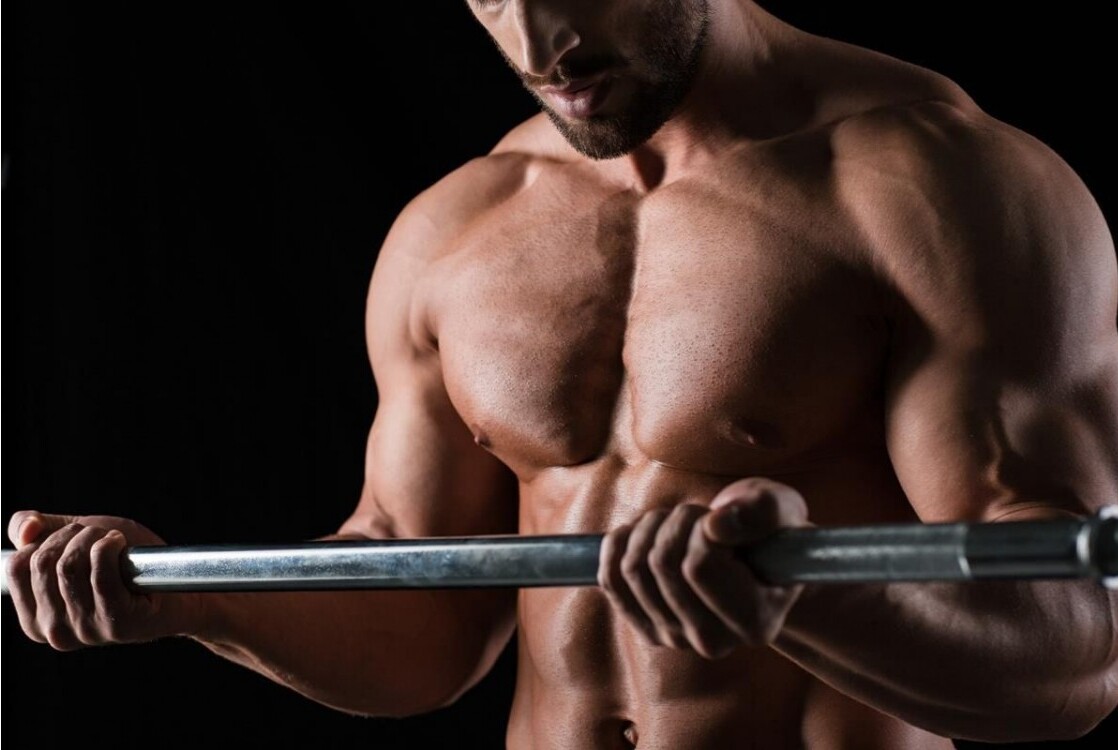
Chest workout at home can be effective using bodyweight exercises and minimal equipment. Push-ups, dips, and resistance band exercises are key. Many people want a strong, defined chest but lack access to a gym. Fortunately, you can perform chest workouts at home without expensive equipment. Bodyweight exercises like push-ups, dips, and chest presses are highly effective. Incorporating resistance bands can add variety and intensity.
These workouts are not only convenient but also save time and money. Regular exercise also improves overall health and fitness. With consistency and proper form, you can build a strong chest at home. Start with basic exercises and gradually increase the difficulty. This approach ensures progress and reduces the risk of injury.

Benefits Of Chest Workout At Home
Working out at home can be very beneficial. Chest workouts at home offer many advantages. These include convenience and cost-effectiveness.
Convenience
Exercising at home saves time. There’s no need to travel to the gym. You can work out at any time. This flexibility helps maintain a consistent routine.
Everything is right there. You can use your own equipment or body weight. This makes it easier to fit workouts into a busy schedule.
Cost-effective
Home workouts save money. There are no gym membership fees. No need to buy expensive equipment either. Many effective chest exercises use just your body weight.
Here are some cost-saving benefits:
- No monthly membership fees
- Lower transportation costs
- Minimal equipment needed
| Expense | Home Workout | Gym Workout |
| Membership Fees | $0 | $30-$100/month |
| Transportation | $0 | $20-$50/month |
| Equipment | $0-$50 | $50-$500 |
Warm-up Routine
Before starting your chest workout at home, it’s crucial to warm up properly. A good warm-up routine prepares your muscles and reduces the risk of injury. It also improves your performance during the workout.
Dynamic Stretches
Dynamic stretches are essential for warming up your chest muscles. These stretches involve movement and help increase blood flow.
- Arm Circles: Stand with your feet shoulder-width apart. Extend your arms to the sides and make small circles. Gradually increase the size of the circles.
- Torso Twists: Stand with feet apart. Place your hands on your hips. Twist your torso gently to the left, then to the right.
- Arm Swings: Extend your arms in front of you. Swing them back and forth, crossing them over your chest each time.
Heart Rate Elevation
Elevating your heart rate is vital for a thorough warm-up. It prepares your cardiovascular system for the workout ahead.
- Jumping Jacks: Stand tall with your arms at your sides. Jump up while spreading your legs and raising your arms overhead. Return to the starting position.
- High Knees: Stand in place and jog while lifting your knees as high as possible.
- Butt Kicks: Stand in place and jog, bringing your heels up to touch your buttocks.
Follow this warm-up routine to ensure your chest muscles are ready. This will help you get the most out of your workout and stay injury-free.
Bodyweight Exercises
Bodyweight exercises are a great way to build chest muscles at home. They don’t need any equipment and can be done anywhere. They help improve strength and endurance.
Push-ups
Push-ups are the most common chest exercise. They target the chest, shoulders, and triceps. There are many variations to keep your workout interesting.
- Standard Push-Ups: Start in a plank position. Lower your body until your chest is just above the ground. Push back up.
- Wide Push-Ups: Place your hands wider than your shoulders. This targets the outer chest muscles more.
- Diamond Push-Ups: Place your hands close together under your chest. Form a diamond shape with your fingers. This variation targets the inner chest and triceps.
Plank Variations
Plank exercises are great for the core and chest. They help build endurance and stability. Different plank variations can make your workout more challenging.
- Standard Plank: Hold your body in a straight line. Keep your elbows under your shoulders. Engage your core and chest muscles.
- Side Plank: Lie on one side with your legs stacked. Lift your hips off the ground. Hold this position.
- Plank to Push-Up: Start in a plank position. Lower yourself into a push-up. Return to the plank position.
| Exercise | Reps | Sets |
| Standard Push-Ups | 10-15 | 3 |
| Wide Push-Ups | 10-12 | 3 |
| Diamond Push-Ups | 8-10 | 3 |
| Standard Plank | 30-60 sec | 3 |
| Side Plank | 30-45 sec | 3 |
| Plank to Push-Up | 8-10 | 3 |
Advanced Techniques
Advanced chest workouts at home can help you push your limits. These techniques target different muscle groups in your chest. They also improve strength and endurance.
Plyometric Push-ups
Plyometric push-ups are great for building explosive power. They also enhance muscle coordination. Follow these steps:
- Start in a standard push-up position.
- Lower your body until your chest is just above the ground.
- Push up explosively so your hands leave the ground.
- Clap your hands together before landing back in the push-up position.
Perform 3 sets of 10 reps. Rest for 1 minute between sets.
Benefits:
- Increases muscle power
- Improves fast-twitch muscle fibers
- Enhances coordination
Time Under Tension
Time under tension (TUT) increases muscle endurance. It involves extending the duration of each rep. Here’s how to apply TUT:
- Lower yourself in a push-up over 3 seconds.
- Hold the bottom position for 2 seconds.
- Push up over 3 seconds.
- Repeat for 10 reps.
Perform 3 sets with 1-minute rest between sets.
Benefits:
- Increases muscle endurance
- Enhances muscle growth
- Improves strength
Using these advanced techniques will intensify your chest workouts. They bring variety and challenge to your routine.
Incorporating Resistance Bands
Resistance bands are a great tool for home workouts. They provide constant tension throughout the entire movement. This helps in muscle activation and growth. You can do many exercises with bands. Below are a few you can try.
Band Chest Press
The Band Chest Press mimics the bench press. It’s excellent for building pectoral muscles. Here’s how you can do it:
- Attach the band to a door or sturdy object.
- Hold the handles and step forward.
- Keep your feet shoulder-width apart.
- Press the bands forward until your arms are straight.
- Return to the starting position slowly.
Repeat for 3 sets of 12 reps. Focus on your form for the best results.
Band Flyes
Band Flyes target the inner chest. They help in defining the chest muscles. Follow these steps to perform Band Flyes:
- Secure the band at chest height.
- Hold the handles with your arms extended.
- Step forward to create tension in the band.
- Bring your hands together in front of you.
- Slowly return to the starting position.
Perform 3 sets of 15 reps. Control the motion for effective muscle engagement.

Creating A Balanced Routine
Creating a balanced routine for your chest workout at home is crucial. It ensures all muscle groups are targeted equally. This balance helps in achieving a well-defined chest. Below are key aspects to consider while creating your routine.
Reps And Sets
Understanding reps and sets is vital for an effective workout. Reps, short for repetitions, refer to the number of times you perform a specific exercise. Sets are the groups of reps you do.
For a balanced chest workout, follow this structure:
| Exercise | Reps | Sets |
| Push-ups | 12-15 | 3 |
| Chest Dips | 10-12 | 3 |
| Incline Push-ups | 8-10 | 3 |
This mix ensures all parts of your chest are worked. Adjust the reps and sets based on your fitness level.
Rest Periods
Rest periods are as important as the workout itself. They allow your muscles to recover and grow. Ideally, keep your rest periods between 60 to 90 seconds. This balance maintains muscle tension and promotes growth.
Here’s a quick breakdown:
- Between sets: 60 seconds
- Between exercises: 90 seconds
Shorter rest periods can increase intensity. Longer rest periods help with muscle recovery. Choose what suits your goals best.
A well-structured routine with balanced reps, sets, and rest periods can make a significant difference. Stay consistent and listen to your body’s needs. Happy training!
Tracking Progress
Tracking progress is essential for achieving your goals chest workout at home. Monitoring your improvements will help you stay motivated and adjust your routine. Below are some effective ways to track your progress.
Logging Workouts
Logging workouts helps you keep track of your exercises, reps, and sets. Use a notebook or a digital app for this purpose. Write down each exercise, the number of sets, and the repetitions completed.
Here is an example table for logging your chest workouts:
| Exercise | Sets | Reps | Weight (if applicable) |
| Push-Ups | 3 | 15 | Bodyweight |
| Chest Dips | 3 | 12 | Bodyweight |
| Dumbbell Flyes | 3 | 10 | 15 lbs |
Logging workouts helps you see your progress over time. This can keep you motivated.
Setting Goals

Setting goals is crucial for measuring success. Goals provide a clear path and keep you focused. Start by defining short-term and long-term goals.
- Short-Term Goals: These can be weekly or monthly targets.
- Long-Term Goals: These span several months or a year.
Here is an example of setting goals:
- Increase push-up reps from 15 to 20 in one month.
- Perform chest dips with added weight in three months.
- Improve dumbbell flyes weight to 20 lbs in six months.
Setting goals keeps you on track and focused. Adjust your goals as needed to ensure continuous progress.
Cool-down And Recovery
After a vigorous chest workout at home, it’s essential to focus on cool-down and recovery. These steps help prevent injury and promote muscle growth. Cooling down aids in reducing muscle soreness and restoring flexibility.
Static Stretches
Performing static stretches post-workout can greatly enhance your recovery. Hold each stretch for at least 30 seconds. This allows your muscles to relax and lengthen.
- Chest Stretch: Stand in a doorway with arms at shoulder height. Lean forward gently.
- Shoulder Stretch: Cross one arm over your chest. Use the other arm to hold it in place.
- Triceps Stretch: Raise one arm over your head. Bend the elbow, reaching down your back, and use the other hand to push gently.
Hydration And Nutrition
Post-workout hydration and nutrition are crucial for muscle recovery. They help replenish lost fluids and nutrients.
| Hydration Tips | Nutrition Tips |
| Drink water immediately after your workout. | Consume a protein-rich snack within 30 minutes. |
| Add electrolytes to your water if you sweat a lot. | Include carbohydrates to restore energy levels. |
| Avoid sugary drinks. | Opt for whole foods like fruits and nuts. |
Proper hydration ensures your muscles function well. Good nutrition helps repair and build muscle tissue.
Frequently Asked Questions
What Are The Best Chest Workout At Home?
Push-ups, chest dips, and resistance band flyes are effective. No equipment needed for push-ups and dips. Resistance bands are affordable.
How Can I Build Chest Muscles Without Weights?
Use bodyweight exercises like push-ups and variations. Incorporate resistance bands for added intensity. Consistency is key.
How Often Should I Do Chest Workouts?
Aim for chest workouts 2-3 times per week. Allow rest days in between. Consistency helps muscle growth.
Can Push-ups Replace Bench Press?
Push-ups can effectively build chest muscles. They target similar muscle groups. For variety, include both in your routine.
Conclusion
Achieving a great chest workout at home is entirely possible. Use these exercises to build strength and muscle. Stay consistent and maintain proper form for the best results. Home workouts offer flexibility and convenience. Start today and see the benefits in no time.
Your fitness journey begins at home.





